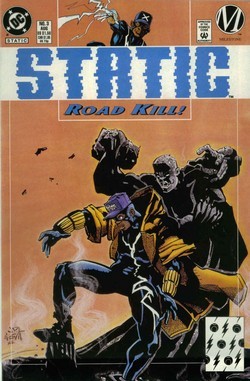Milestone Media: Static #3
By Leroy S. Douresseaux
October 12, 2007 - 20:11
DC Comics
Writer(s): Robert L. Washington and Dwayne McDuffie
Penciller(s): John Paul Leon
Inker(s): Steve Mitchell
Colourist(s): Noelle Giddings
Cover Artist(s): John Paul Leon and Steve Mitchell with Noelle Giddings
32 pp., Color, $1.50
 |
Static #3 (with a cover date of August 1993), entitled “Pounding the Pavement,� is the first issue in which a villain specifically calls out Static (Virgil Ovid Hawkins) for a challenge. The issue opens with Static rescuing customers from Akkad’s Arcade (the setting in which readers first saw Static in action) which has been heavily damaged by fire and destruction to the building itself. Through a flashback, we learn that Virgil, in order to respond to Akkad’s distress, lost his job as a dishwasher.
The day after Static’s heroics, the scene opens at Virgil’s school, Ernest Hemingway High School. While bantering with some of his friends (including Frieda Goren and Larry), Virgil learns that a shape-shifting bad guy who calls himself “Tarmack� (his body is made of malleable tar and he wants to be a “mack�) is raising havoc, threatening more destruction unless Static accept his challenge to fight.
During the short, but explosive battle, Static notices that gawking civilians remain perilously close to the battle scene, so he convinces Tarmack to halt and rejoin the fight away from innocent civilians. Although he claims that Static is a punk looking for an excuse to get out of fighting, Tarmack agrees to resume the lethal festivities on the parking lot of Bradshaw’s in Avalon Mall at midnight of the same day.
Later, while riding the subway, Virgil and the gang debates whether Static should show up later to fight Tarmack. Frieda, who knows Static’s secret identity, directly and surreptitiously engages Virgil in a debate about Static continuing the fight, which she thinks he should be too smart to do. On the other hand, Virgil believes that Tarmack would continue to “call out� Static until he answered the challenge, so why not get it over with now.
Static goes into the final battle using his smarts and devising a clever plan, while Tarmack merely relies on his powers. Considerable though they may be, Tarmack uses them in an unimaginative way, or, as Static says, copying moves he learned from the “T-1000� in the film Terminator 2: Judgment Day. After roundly beating up Tarmack, another costumed figure makes a sudden and surprise appearance.
Writers Robert L. Washington and Dwayne McDuffie, at this point in the Static comic book series, continue to spin enjoyable yarns. Like the classic Amazing Spider-Man comics of Steve Ditko and Stan Lee, they deftly mixed fun superhero fight comics with teen drama. Virgil’s domestic life is as interesting as his life in a costume; sometimes more so. That’s mainly because Washington and McDuffie emphasized strong character development and writing in the supporting characters. The original Spider-Man stories also offered likeable characters, although Stan Lee’s scripts rarely engaged the supporting cast as well as Washington and McDuffie did here.
The art team of John Paul Leon (pencils), Steve Mitchell (inks), and Noelle Giddings (colors) were responsible for creating a look that depicted superhero comics in a fashion recognizable to readers familiar with the genre. However, they also created a look that captured Virgil’s environment or “home base� in visuals that were relevant to the time in which this comic was published – much the way Ditko drew an ideal New York City – an urban landscape that readers within and without NYC recognized.
Related Articles:
Static Shock #1
Static #5 (Milestone Media)
Milestone Media: Static #4
Milestone Media: Static #3
Milestone Media: Static #2
Milestone Media: Static #1
